The Samsung 850 EVO 4TB SSD Review
by Billy Tallis on July 11, 2016 10:00 AM ESTMixed Random Read/Write Performance
The mixed random I/O benchmark starts with a pure read test and gradually increases the proportion of writes, finishing with pure writes. The queue depth is 3 for the entire test and each subtest lasts for 3 minutes, for a total test duration of 18 minutes. As with the pure random write test, this test is restricted to a 16GB span of the drive, which is empty save for the 16GB test file.
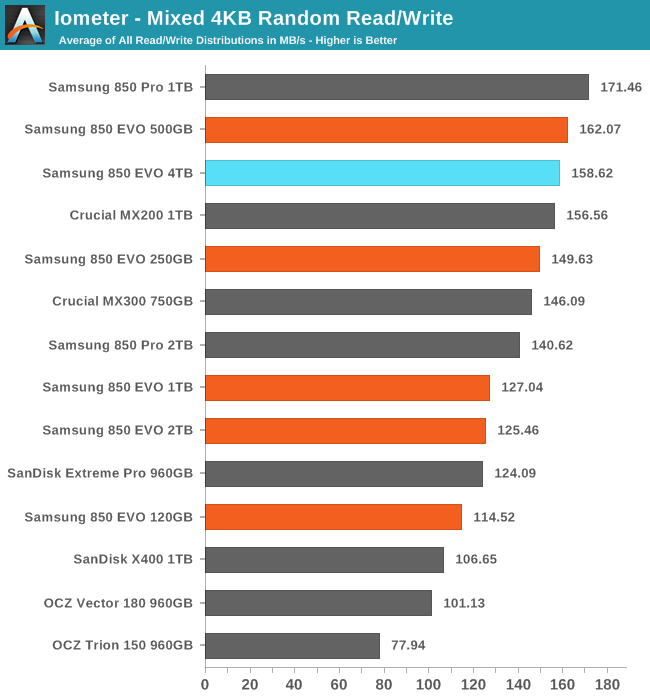
The mixed random I/O performance of the 4TB 850 EVO is much better than the other large 850 EVOs, putting te 4TB model close to the top of the chart.
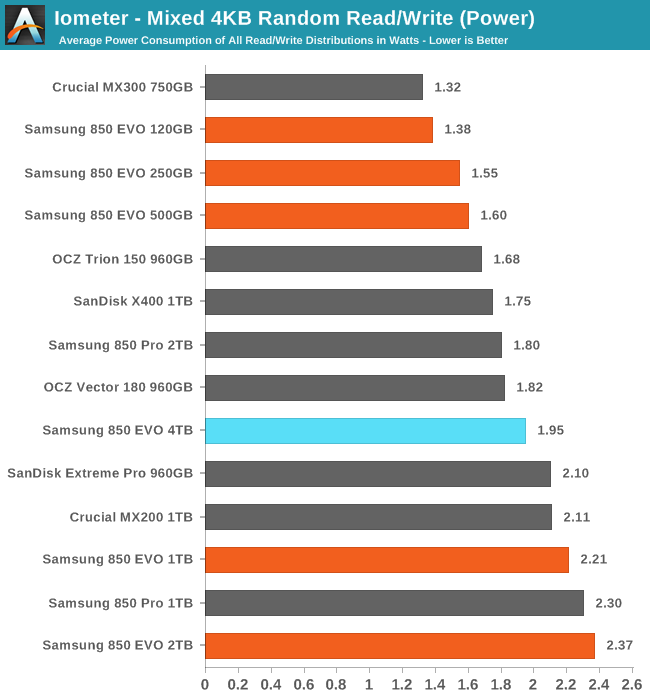
The 4TB 850 EVO also manages a large reduction in power usage as compared with the 1TB and 2TB 850 EVOs, making the 4TB much more efficient.
 |
|||||||||
Unlike the other 850 EVOs, the 4TB never loses performance as the proportion of writes in the test workload increases. Meanwhile, the power draw is essentially constant until near the end of the test.
Mixed Sequential Read/Write Performance
The mixed sequential access test covers the entire span of the drive and uses a queue depth of one. It starts with a pure read test and gradually increases the proportion of writes, finishing with pure writes. Each subtest lasts for 3 minutes, for a total test duration of 18 minutes. The drive is filled before the test starts.
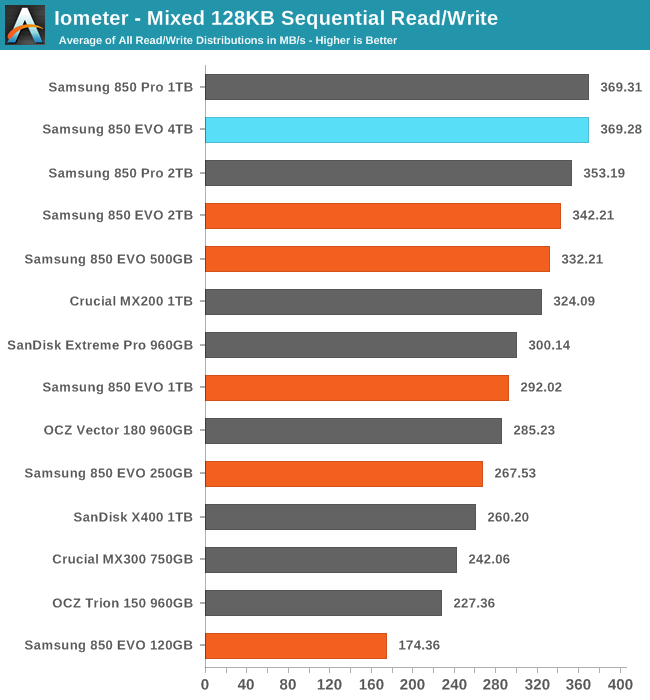
The 4TB 850 EVO is essentially tied for the best mixed sequential read and write performance.
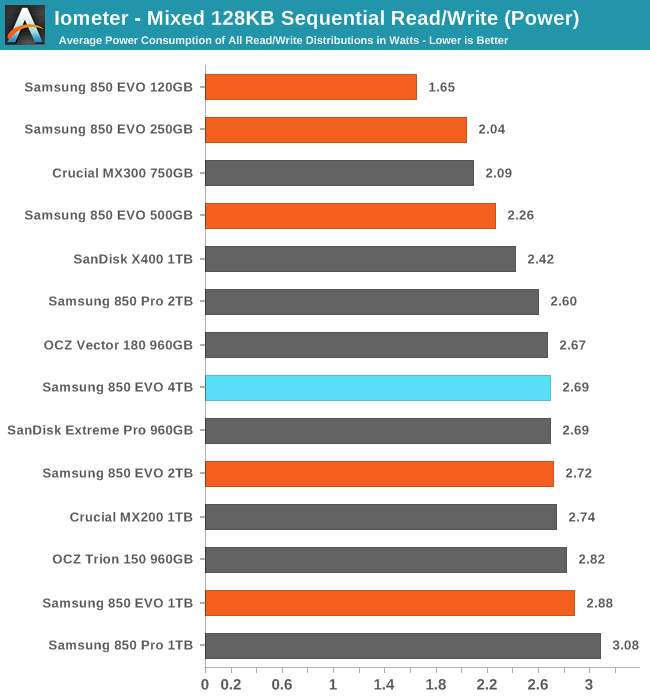
The 4TB 850 EVO averages using slightly less power than the 2TB model, and it is one of the most efficient of the large drives.
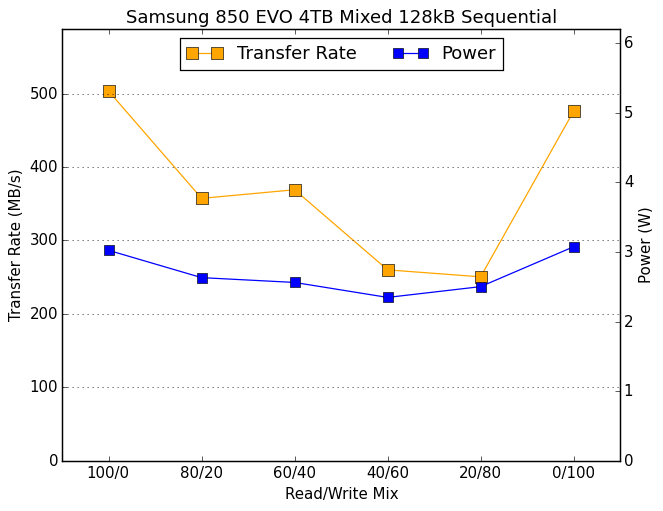 |
|||||||||
The usual pattern is for performance on this test to resemble a bathtub curve, but the 2TB 850s and the 4TB 850 EVO don't lose as much of their performance during the first half of the test, leading them to bottom out much later than most other drives.










145 Comments
View All Comments
SetiroN - Monday, July 11, 2016 - link
I mean I understand and agree that Samsungs are the better drives to buy at lower capacities right now, but if you needed 4TB or more you just have to be silly to spend $700 more.Let me say that again: $700.
Oxford Guy - Monday, July 11, 2016 - link
"I can't honestly think of any good reason to buy something other than samsung SSD"1) People who were burned by the very poor steady state performance (according to one professional review site) of the original 840 120 GB.
2) People who were burned by the problems with the 840 EVO and who aren't impressed by the kludgy work-around of re-writing data again and again.
3) People who haven't been impressed with generations of BS power consumption specs. It's only recently that we're now seeing ratings for read/write power consumption. Prior to that, though, there generations/years of Samsung SSDs with ".17 watt" power consumption nonsense. This was not only the only thing on their site for SSDs that used plenty of watts when working (like the 830 and 840) — consumers even advised each other in the comments in places like this to choose Samsung because of the very low power consumption (even though the 840 topped the chart here, as I recall, for consuming the most watts when writing).
But, that said, the 850 seems to be the first decent TLC SSD so I'm glad the company has made significant improvement.
Impulses - Monday, July 11, 2016 - link
I guess I got lucky, went straight from 830s to 850 EVOs & SM951, have yet to get burnt. Though to be honest, every other SSD OEM out there (including Intel) had at least one catastrophic scenario like the 840's (often worse, resulting in data loss), if not several such scenarios.I'm not completely excusing Samsung, because their handling of the situation wasn't optimal (went from trying to brush it under that rug to a kludgy fix that didn't even cover the non EVO)... But I'm also not holding it against them.
Palorim12 - Tuesday, July 12, 2016 - link
1. They released a fix it a week or two ago.2. completely fixed in April of 2015. Doesn't constantly rewrite data, the new algorithm itself fixes the read speeds and the idle write thing they have is a just in case the algorithm can't fix it.
3. Use desktops, so can't say anything about power consumption.
romrunning - Monday, July 11, 2016 - link
Sure, the *1TB* Ultra II is cheaper per GB. But show me where I can buy a 4TB Ultra II, and then you'll have an apples-to-apples comparison.ddriver - Monday, July 11, 2016 - link
Well, you can't, but you can buy 4 1TB, put them in RAID 0 and get 2 GB/sec vs 500 MB/sec from the EVO.So almost the same capacity (it is 960 GB really) at 4 times the speed (and 4 times less reliability ;) for 2/3 of the cost.
quiksilvr - Monday, July 11, 2016 - link
That is only a viable option if you have a desktop computer or a Thunderbolt external drive enclosure. An initial price of $1499 is a lot but 4TB is ridiculous. And if that price drops to $999, that would be even more bonkers. I remember the days when having just 1TB was that price. The fact that we are at 4 times the capacity for the same price and WAY better performance is nuts.TemjinGold - Monday, July 11, 2016 - link
And 4 times the headaches having to deal with the RAID setup.mapesdhs - Wednesday, July 13, 2016 - link
And the reliability issue of one device failure trashing all the data, though one could get round this by using four 2TB in RAID10 which wouldn't be so bad, but still a lot of ports, etc.Gigaplex - Monday, July 11, 2016 - link
I'd also need a RAID controller with 4 spare SATA ports.